Selected Images In The Artistic Photography Contest Of The Ocean
The Underwater Photography Guide Site Has Announced The Winners Of The 8th Underwater Photography Contest And Ocean Art Winners.
In this competition, images from 78 countries around the world competed in 16 categories, and a prize of 85 thousand dollars was awarded to the winning photographers.
The underwater photography guide site has announced the winners of the 8th underwater photography contest and ocean art winners. Underwater photography is a branch of photography in which aquatic animals or underwater attractions are photographed. The selected works included sad and frightening images.
Motion control is significant in underwater photography; Because, unlike the surface of the earth, the subjects and the photographer are always moving. Light reflection is another factor that significantly affects underwater photography.
Amateur photographers are always surprised to see a photo of a large fish taken underwater. The camera captures subjects underwater much smaller than the surface. The deeper the photographer goes into the water, the less light he will access, and the red color will be more prominent in the photos.
Everything is different underwater. For example, lighting follows other principles and patterns.
Underwater, light should be about six times stronger than on land, depending on the depth and distance to the subject. Because radio signals can be challenging to deal with underwater, constant or ambient light or flashes that connect directly to the camera should be used.
Underwater photography is as tricky as it sounds exciting and scary. In this context, the photographer must also have learned to dive entirely to survive in underwater photography. However, this type of photography is essential; Because through that, more people will learn about the habitat of aquatic animals and can make a difference in preserving the unique animals living in the underwater environment.
Also, if more people take pictures of the oceans and share them, the interest in diving and efforts to preserve the oceans will increase.
The winners of the 8th underwater photography competition and the winners of the ocean art also had extraordinary images, and the works of the winners included sad and frightening images. In this competition, photos from 78 countries worldwide competed in 16 categories, including conservation, underwater art, large macro, wide angle, etc., and a prize of 85,000 dollars was awarded to the winning photographers.
The main prize of this competition was awarded to Greek Leisure from the “Cold Water” category. The undeniably eye-catching photography of this image shows the jaws of a crab eater moving between ice floes in the icy waters of Antarctica. We recommend clicking on the pictures to view them in their original dimensions.
First place in the “cold water” category.

- Illustrator Name: Greek Leisure
- Photo location: South Pole
The photographer says in the description of this photo:
While traveling in a small sailboat, we discovered many creatures by diving under the surface of the Antarctic Peninsula. Although the conditions were harsh, with a temperature of minus one degree Celsius; However, we captured some fantastic images of marine animals in their home, which is a fragile ecosystem like this one. On this trip, in addition to the crab-eating jaw, a species of the earless jaw family, many other marine animals were also observed to be affected by global warming or ice melting.
Despite the name of this animal species, the crab-eating jaw does not eat crabs. A type of fish called krill makes up 95% of the diet of a crab eater. The tooth-shaped structure of the lobster’s jaw leads to the hunting of krill fish. Like balloon whales, they suck up water containing krill, then close their jaws and squeeze the water between their specialized teeth, trapping the krill inside their bodies.
First place in the “wide angle” category.
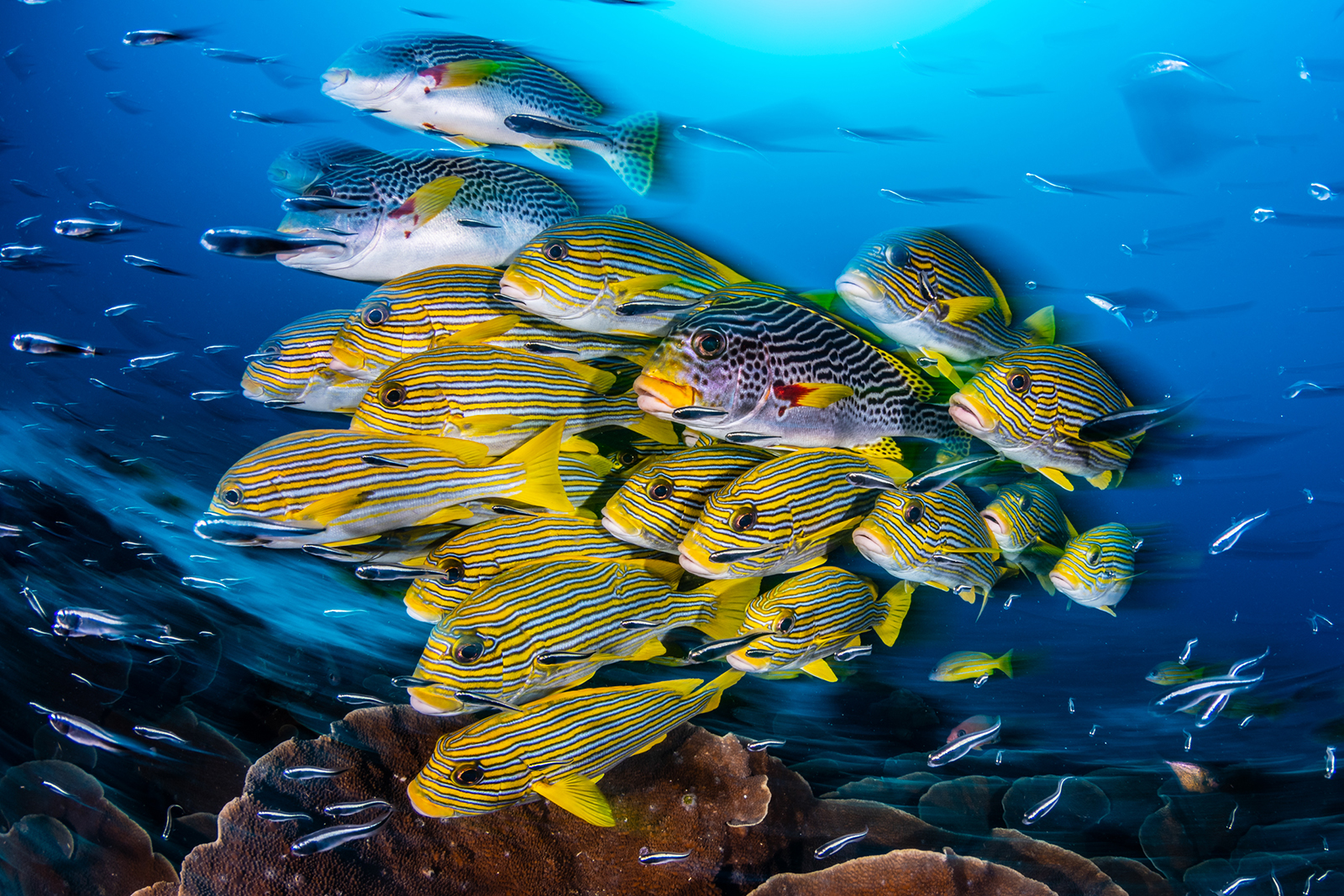
- Name of the photographer: Nicholas Moore
- Photo location: Indonesia
The photographer says in the description of this photo:
This photo was taken in November 2019 on the last morning of a direct flight to Raja Ampat, Indonesia. We were snorkeling at Sandrock Jetty when we came across a group of ribbon wrasse about 25 meters from the coral reef. These types of fish are nocturnal predators, But during the day, they form dense schools in the rocks of Raja Ampat and take shelter in the strong current of water. To bring the fish into focus in this image, I slowed down the shutter speed and used a quick motion to blur the background. This effect also helped to strengthen the unity of this group of fish that moved in a group and the same direction. These fish are found in the Indian Ocean and the western Pacific Ocean next to coral reefs. The young type of these fish have black stripes and live alone in deep water. With age, the black becomes an outline, and the lines become more yellow and increase. The bright colors of these fish help them blend in with the corals that live there. These fish feed on crabs, shrimps, sea snails, and worms and are precious commercially as food fish.
First place in the “Macro” category.
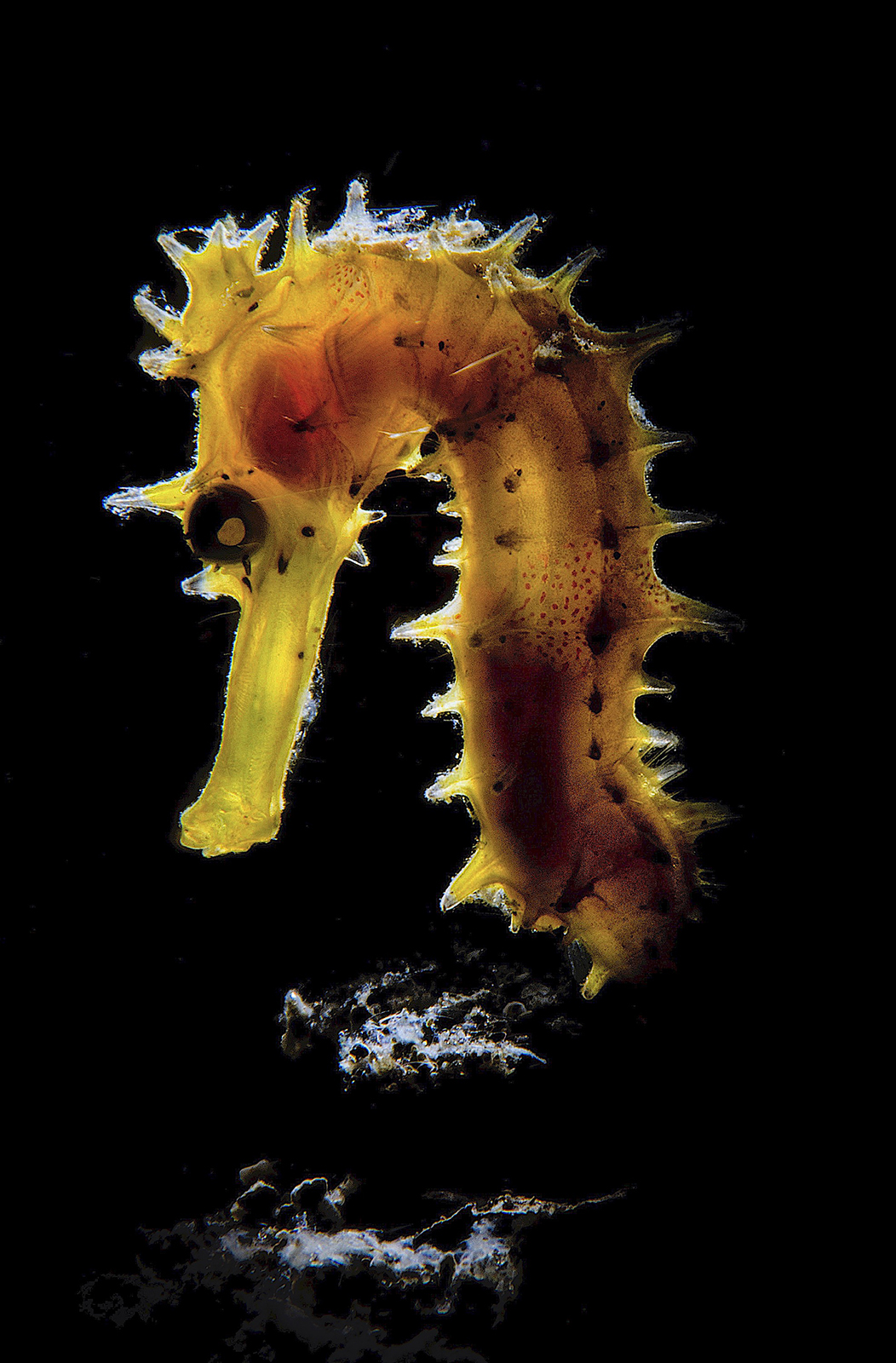
- Photographer’s name: Stefano Sarbi
- Photo location: Philippines
The photographer says in the description of this photo:
This photo was taken in Puerto Galera, Philippines. I saw this seahorse during a daily dive. Seahorse or horsefish is a type of fish from the needlefish family found in tropical and temperate waters around the world. The body length of seahorses varies from 16 mm to 35 cm. The unique characteristic of this type of fish is that the female transfers the eggs to the male’s body and the male carries them until delivery. The duration of pregnancy in seahorses varies between 10 days and six weeks. Monogamy in some species is another unusual feature of seahorses. This unique fish is tall, has a horse-shaped head, and swims upwards. Most of the time, seahorses remain motionless. They do this by sticking their sticky tails in the corals and seaweeds, and with this movement, they create camouflage in front of their enemies. I shot this fish by placing the flash behind its snout and creating a background light. A snot is a tube or similar object placed on a studio light or portable flash that allows the photographer to control the direction and radius of the light beam.
First place in the “Marine Life Behavior” category.
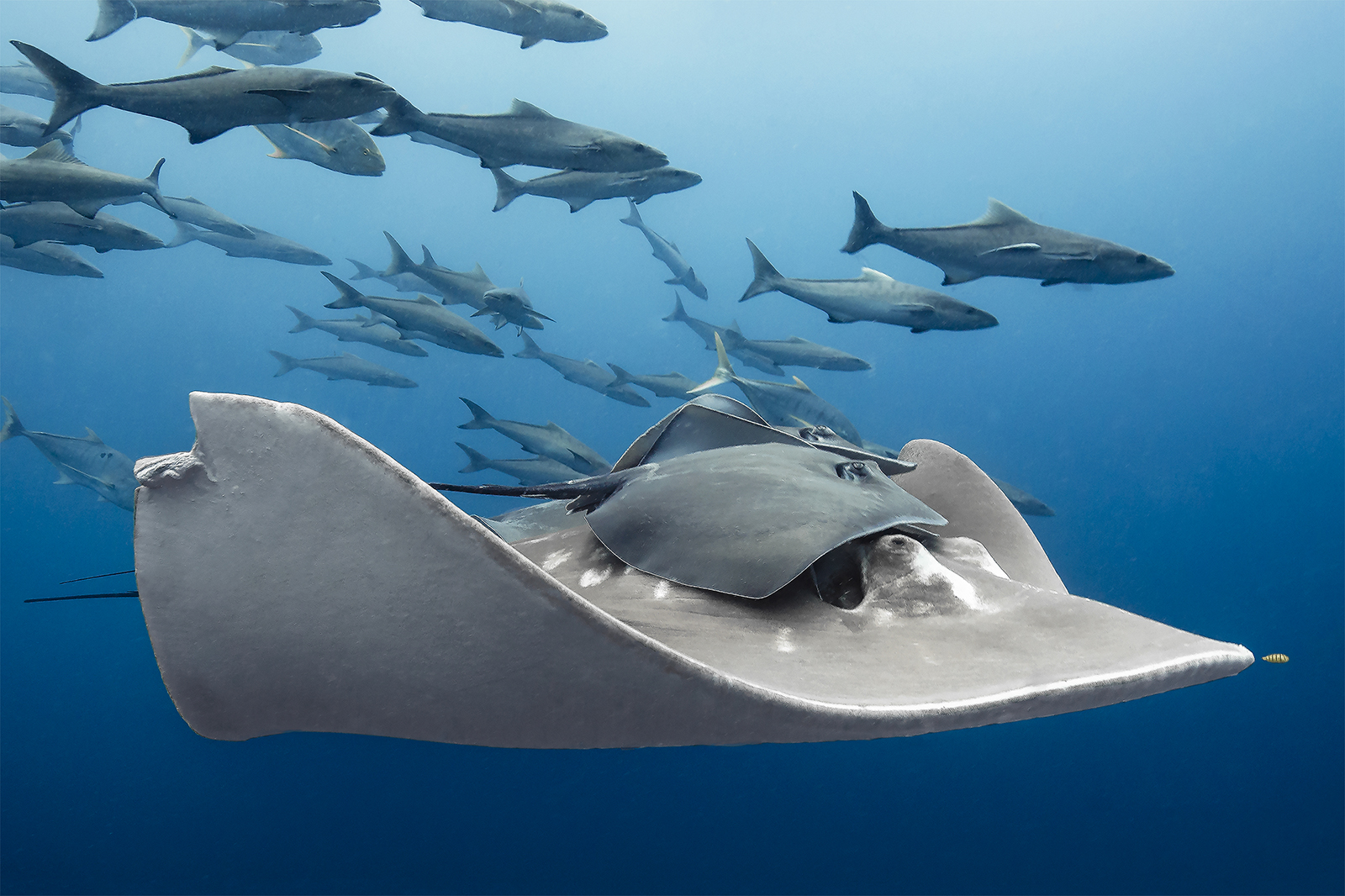
- Photographer’s name: Paula Viana
- Photo location: Australia
The photographer says in the description of this photo:
This creature is a species of table fish, which is also called dal Mahi. They have a broad but uncertain distribution in the tropical Indo-Pacific from southern Africa to Polynesia. They are the result of the evolutionary cycle of sharks. Table fishes usually live in large groups. The ossification of the fish table consists of cartilage, a complex but softer material than bone. When a fish reaches a new habitat, its body uses the light received through the retina to create the desired color on its surface. After that, the body of the table fish sends different pigments to the target cells to stain the new habitat. The table fishes become the same color as their environment within 5 to 8 seconds. They use their tails to defend themselves; Because there is a spear-like bite in their seats. These bites are poisonous, and if medical measures are not taken, the wound caused by the edge of the table fish may become infected and lead to the person’s death. In this picture, small fish are riding on a larger table fish. By doing this, they seek to protect themselves from predators and save energy. Also, this work helps to preserve the big table fish. This image was recorded in Queensland, Australia.
First place in the “Portrait” category.
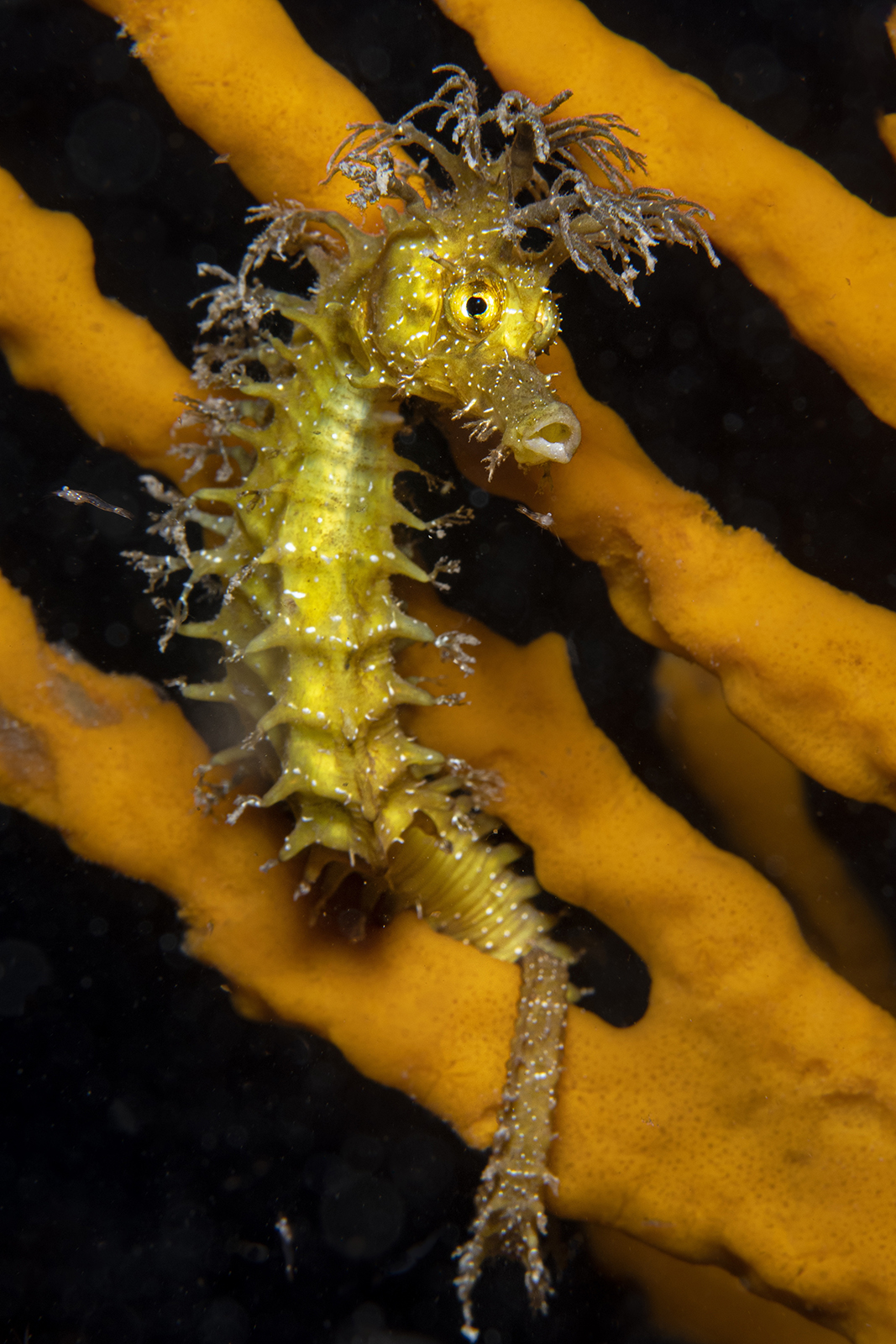
- Photographer’s name: Virginia Salido
- Photo location: unknown
The photographer commented on this photo: “I met this beautiful seahorse during a night dive, and I was immediately surprised by his creative hairstyle.”
First place in the category of “soft.”

- Photographer’s name: Jenny Stock
- Photo location: Australia
The photographer says in the description of this photo:
The Mooloola River in Australia is a treasure trove of mollusks. More than 350 species have been found on the 600-meter edge of the river. However, the real challenge is getting a photo capturing these tiny creatures’ stunning forms. I fell in love with sea snails and returned to the river every weekend for four months, trying to get an image that captured the bright purple of this type of snail against a black background. These types of snails are a large and successful group of gastropod marine mollusks, which means “bare snails.” Famous for its bright colors, this type of snail is informally known as a sea snail.
First place in the “Super Macro” category.
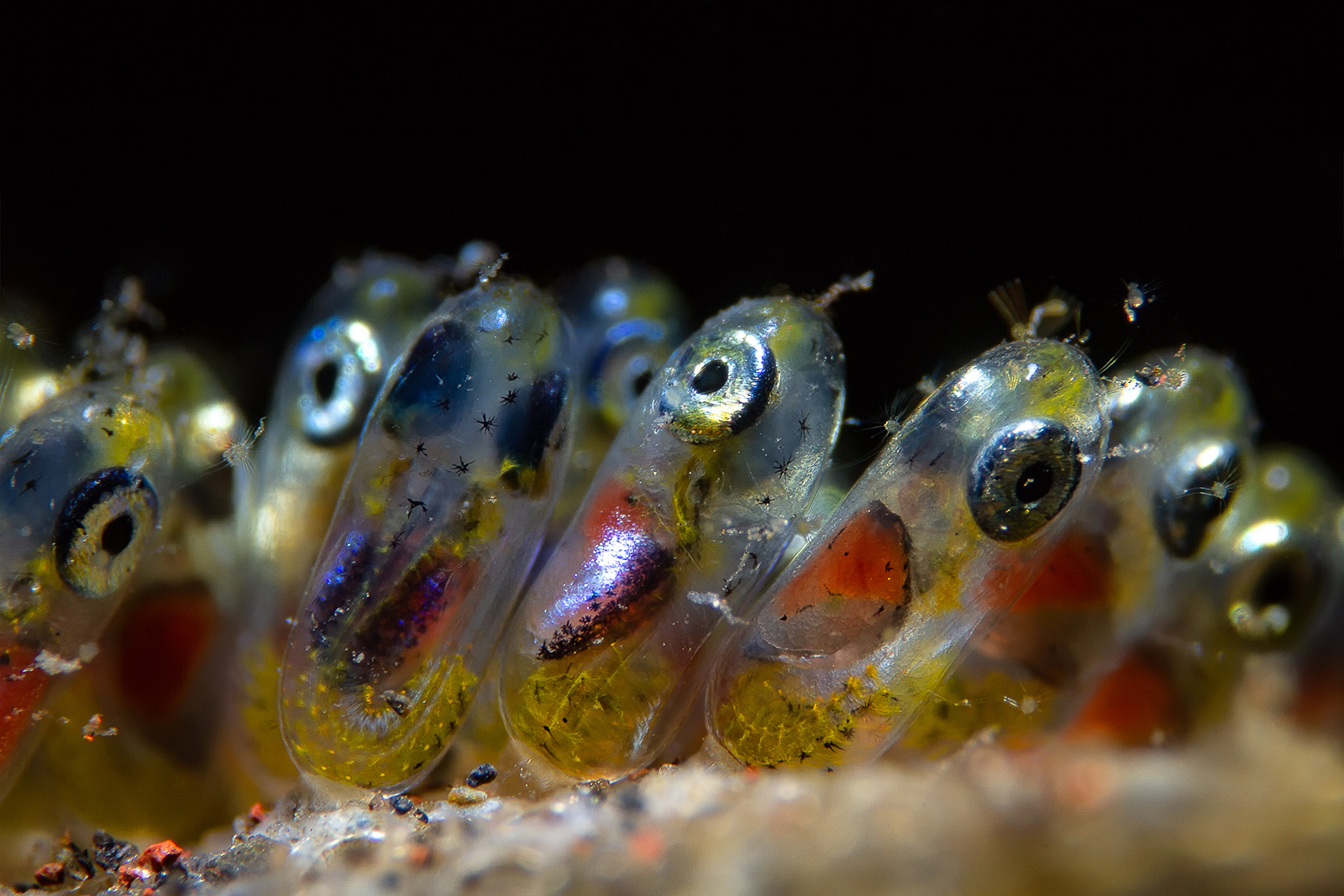
- Photographer name: Paolo Isgro
- Photo location: unknown
The photographer says in the description of this photo:
About twenty-eight species of clownfish have been identified. This type of fish lives in salty waters. The common name of this fish is clown fish or anemone fish. The reason why clown fish is named is because of the coloring of the body of this fish. This fish is resistant to the poisonous tentacles of sea anemones. Some scientists believe that the special mucus on the body of this fish causes this resistance. Clownfish have a kind of symbiotic relationship with sea anemones. Clownfish live next to sea anemones, and other animals cannot hunt them. Also, the presence of clownfish causes different animals to approach the sea anemones and provides food for the anemones. This fish is one of the best options for keeping and is almost the most popular fish in saltwater aquariums. I spent a lot of patience to focus and take this photo, which resulted from clownfish spawning. My dive master was able to find the clownfish eggs and help me set up the space to photograph them. I used a 24mm lens, an electronic reverse ring adapter, and a 40mm extension ring to get a super zoom.
First place in the “black water” category.
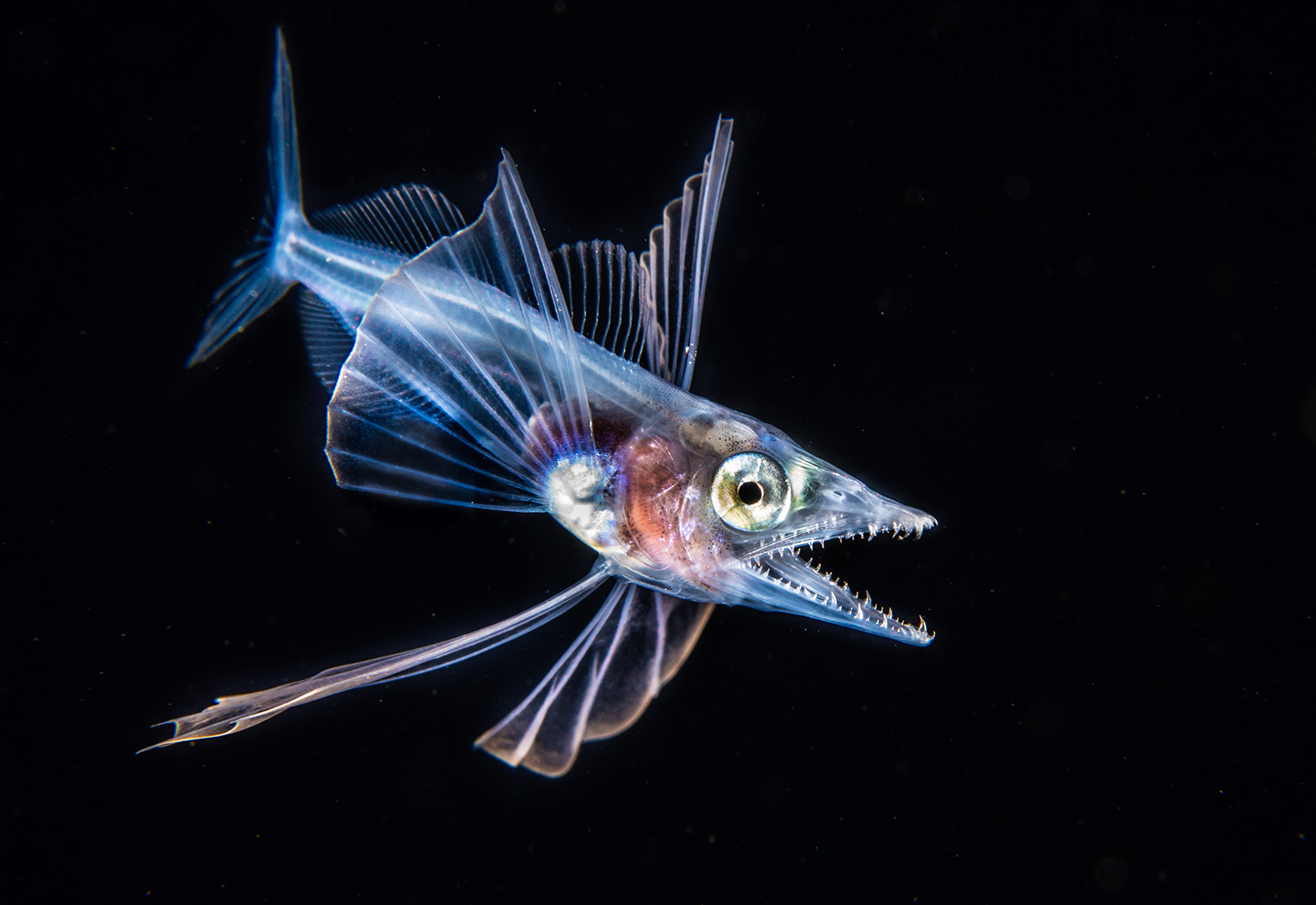
- Photographer’s name: Fabian Market
- Photo location: Black Sea
The photographer says in the description of this photo:
Juvenile fish can be observed while diving in the Black Sea; Because some of these species start their life at 200 meters of water level. Finding and photographing these tiny fish is undoubtedly one of the fascinating aspects of deep-sea diving. These fish live on deep sediments and wait for prey that passes by. They have a very different morphology from adults, with a colossal head and pelvic and pectoral fins. When disturbed, these fish can dive deep into the water. Before taking the first photo of this beautiful juvenile, I was careful to dim my lights and point the blinkers correctly to avoid overexposing the fish’s shiny eyes and adequately illuminating the fins.
First place in the “Protection” category.
- Photographer’s name: Shane Gross
- Photo location: unknown
The photographer says in the description of this photo:
My diver friend cried and said he had found a long-dead turtle tangled in a fishing net. I set up my camera to photograph this turtle; Because pictures like this can be a warning for the future. This photo is a sign of the waste of nature thanks to the carelessness of humans. We don’t want other turtles or creatures to suffer the same unfortunate fate.
First place in the “Underwater Art” category.
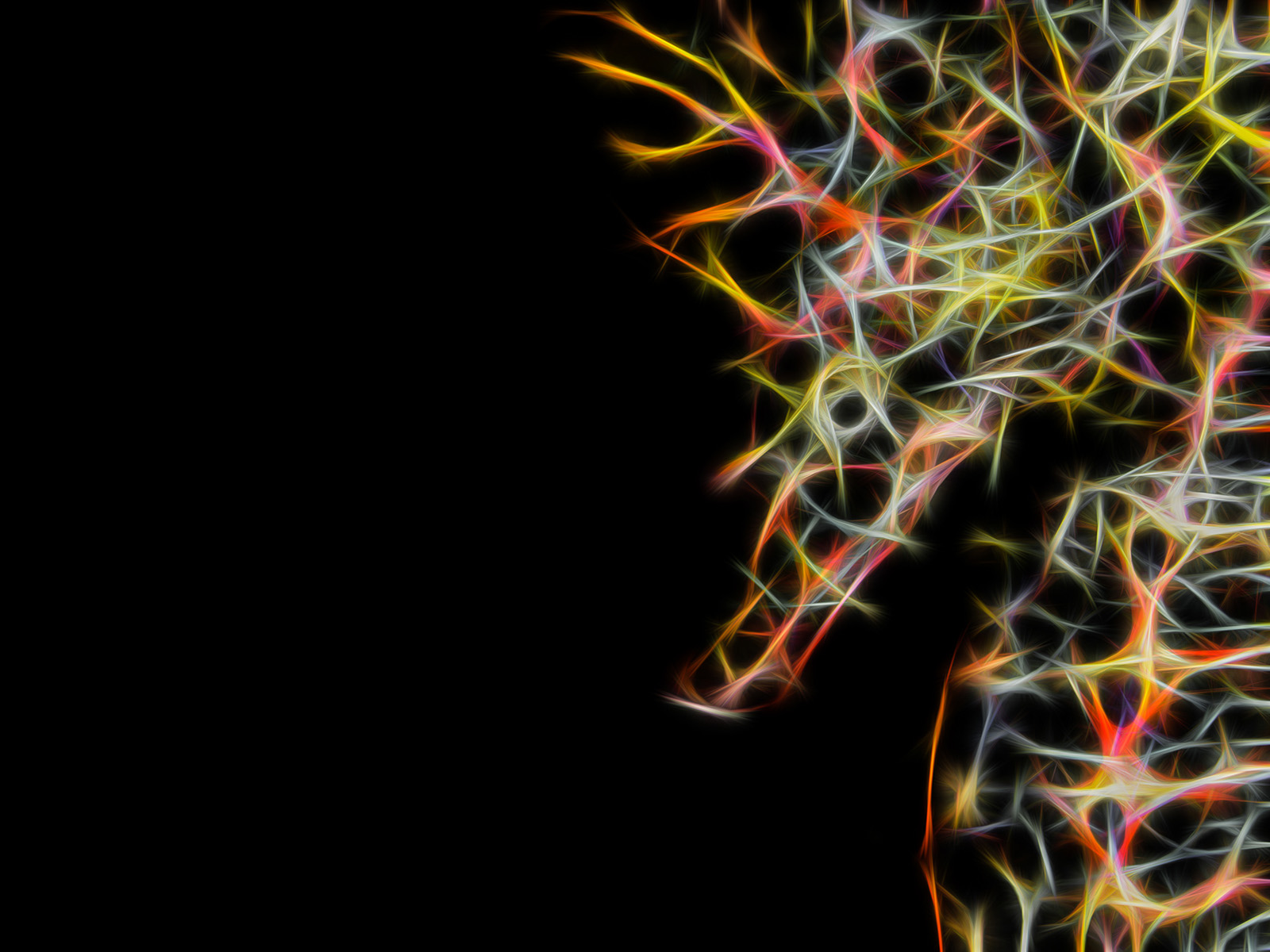
- Photographer name: Francis Sedano
- Photo location: unknown
1st place in the “Novice Macro” category

- Illustrator Name: Julie Casey
- Photo location: unknown
First place in the category “Compact viewing angle.”

- Photographer’s name: Talia Grace
- Photo location: Australia
The photographer says in the description of this photo:
The golden weed, or yellow-crowned weed, is a species of clinid fish found around Australia and New Zealand. Their diet includes crustaceans and small fish. The length of this type of fish can reach 22 cm. Before taking the photo, I had never seen or even heard of this majestic, skillfully camouflaged monarch. This rare sighting requires luck and persistence to capture a particular image. Yellow-crowned weeds can also be found deep in Australia’s Shelly Beach Sea Plant Gardens. In terms of appearance, they are very similar to their living environment. The color of this type of creature is almost the same. They are the best masters of makeovers. The only way to get a shot like this is to linger, stay still, and wait for the perfect moment to be captured.
First place in the category “Compact Macro.”

- Photographer’s name: Stan Shen
- Photo location: unknown
The photographer says in the description of this photo:
This type of fish, known as lemon gobi, is a type of poisonous fish. They have a variety of body colors and can be dark brown or pale yellow. Also, this type of fish has vertical blue lines around its eyes and gills. This type of fish is also booming in the aquarium trade, and many of them are also bred in aquariums. In this picture, you can see the spawning of this type of fish. The remarkable thing was that lemon goby spawned on a piece of glass waste. This shows how fish can coexist with human waste. Seeing these fish magnanimously using human waste to lay their eggs was unforgettable.
First place in the category “compact behavior.”

- Illustrator Name: Ferns Lorenz
- Photo location: unknown
The photographer says in the description of this photo:
I captured this photo at a grooming station. A cleaning station is where aquatic animals gather and are cleaned by smaller organisms. Such stations exist in freshwater and marine environments and are used by animals, including fish, sea turtles, and hippos. The cleaning process involves removing parasites from the animal’s body (both externally and internally). This process is carried out by various smaller animals, including cleaner shrimps and numerous species of cleaning fish, especially eels and collars. The cleaner fish removes the parasite from the skin and eats it. When the animal approaches the grooming station, it opens its mouth completely or positions its body in such a way that it is a sign that it is being cleaned.
To see all the top images from each category and some interesting honors, head to the Underwater Photography Guide website. The judges of this contest admitted that the photos submitted this year were exceptional, and the judging was tough to choose the winner.











